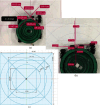Design and Performance Analysis of a Mecanum-Built Perturbation-Based Balance Training Device
- PMID: 38586182
- PMCID: PMC10997419
- DOI: 10.1155/2024/3622556
Design and Performance Analysis of a Mecanum-Built Perturbation-Based Balance Training Device
Abstract
This study proposes a mecanum-built perturbation-based balance training device aimed at improving motor adaptive skills for fall prevention in individuals with neurological disorders or the elderly. Incorporating multidirectional fall simulations in line with modified constraint-induced movement therapy, the device's efficacy was evaluated by measuring the distance traveled and peak acceleration under different static loads (20, 30, and 40 kg) and input accelerations (1, 2, and 3 m/s2). A pilot study with 10 subjects was conducted to assess device performance, utilizing repeated measures analysis of variance and Bonferroni's post hoc analysis. Results indicated a load-dependent reduction in distance traveled, with an average mean difference of 0.74-1.23 cm between the 20 and 40 kg loads for trials of 9 and 18 cm, respectively. Despite varying loads, the device consistently achieved near-anticipated peak accelerations, suggesting its capability to induce effective perturbations. The study also observed a significant lateral movement preference, suggesting adjustments to pulse width modulation and time period may optimize lateral movement performance.
Copyright © 2024 Jaison Jacob Mathunny et al.
Conflict of interest statement
The authors declare that they have no conflicts of interest.
Figures







References
-
- Mansfield A., Schinkel-Ivy A., Danells C. J., et al. Does perturbation training prevent falls after discharge from stroke rehabilitation? A prospective cohort study with historical control. Journal of Stroke and Cerebrovascular Diseases . 2017;26(10):2174–2180. doi: 10.1016/j.jstrokecerebrovasdis.2017.04.041. - DOI - PMC - PubMed
LinkOut - more resources
Full Text Sources

